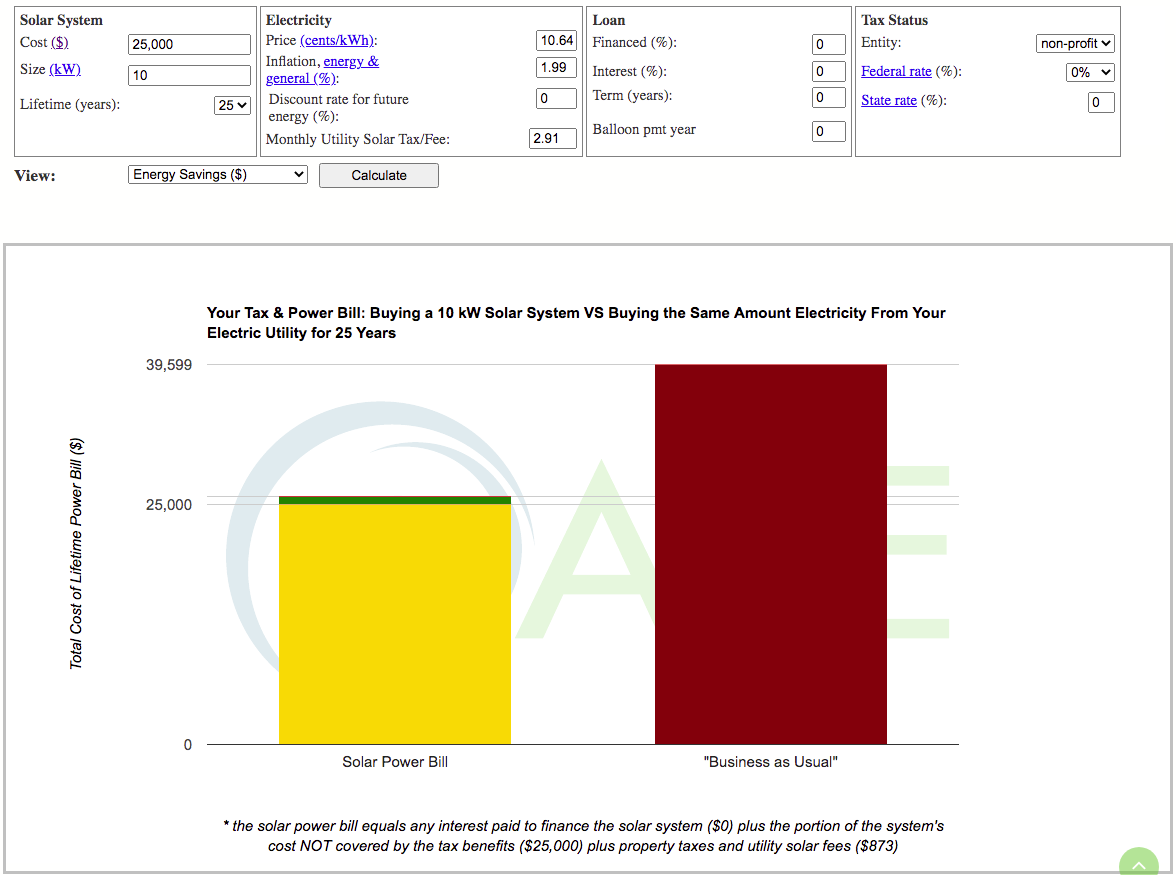Granted it isn’t only for the potential of saving money that we might want to put solar on our home, business, school or place of worship. After all, greenhouse gas emissions are literally killing us. Money is a necessary construct though, if you’re going to install solar. The sunshine is free but it does cost something to install a system. AIRE’s benefit calculator lists the most important considerations at the outset and then allows you to insert your numbers to spit out a benefit graph. We’ve long had a calculator published on our website and this update adds some key variables.[1] Here’s an example that shows why the variables matter, and why good policy (which we DON’T have) also matters.
The costs and benefits of solar aren’t all natural law. Most are constructed via policy and regulation and these rules work at odds against solar by and large.[2] Lets say your church is planning to install a system so it can spend more money on feeding the hungry and less on “feeding a giant investor-owned utility’s” profits. With relatively few barriers (i.e. see the way we set the variables in this example), solar can help feed the hungry as the example below shows.

Take the same system and plop it on the roof of a church in my utility service area (Blue Ridge Energy in Boone, NC) and see what happens. Though still feeding the hungry, now the church pays a “solar punishment fee” too. The utility gobbles up some of the benefit, taking some of it from the hungry, as the chart below shows.

If we were to add a loss factor for net metering [3] this chart would change yet again, because now you’re generating electricity that you can’t use (a surplus) and selling it to your utility via a credit on your power bill for more or less 50 cents on the dollar, plus you may end up surrendering credits you’ve banked at the end of the cycle. One more thing about this example. Since we’re using a religious entity as the hypothetical, it isn’t able to benefit from the tax incentives otherwise available. There are legal and ethical ways for doing this but must be evaluated judiciously. Sometimes the factors align and sometimes they don’t, so it’s case-by-case.
We’ve seen lots of “benefit calculators” out there in web-world and some are downright misleading. We don’t want anyone getting into solar solely for financial logics only to say a year out, “hey, what happened to my benefit!!!???” Use AIRE’s calculator, use some others too, ask critical questions, analyze carefully and make your best decision. We don’t assume “friendly” default numbers, so you’ll have to do some thinking just to use ours which is a good thing.
—
[1] Our work has always been aimed at “optimizing” these variables since anyone wanting solar now must work within those constraints. Of course, we want to help inform policy activism and there’s good defensive work being done in that important arena.
[2] Good policy and regulatory behavior involves a lot of wonky minutia. Most people would prefer a trip to the dentist- no offense to you dentists!- than to think about what’s behind the numbers on their power bill. Suffice it to say that the way rates, costs, fees, and economics are worked out in state utility commissions are a produce of political power, not the natural laws of physics, or even the dismal laws of economics. Rather, they are indeed products of corporate power in a contested space.
[3] Maybe we will soon, but net metering is under constant attack by the utilities, their lobbyists and trade organizations. The example used in this post assumes that every kilowatt of solar will be used by the church, thus negating the loss of selling it’s excess solar to the utility for half the price it pays the utility for energy. It assumes a “Net Billing” rate schedule which is different that Net Metering. These considerations are fairly straight forward though not something to sketch out on a napkin before you invest.